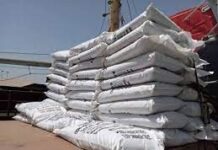with Abdoulie G Dibba
This column is devoted to monitor and report on issues that are relating to production, processing, preservation and marketing of Agricultural products with the ultimate goal of ensuring food security in the Gambia as well as the interventions of Government and Non-governmental Organizations.
Activista seek to empower and enable the young to actively participate in the social, political and economic activities of their country as it affect their lives.
In order for the youth to do this effectively said Saibeh Susso, they need to be capacitized on the policies, the laws and the regulations governing the social, political and economic activities of their country.
This is precisely the reason why Activista decided to train the youth for them to take charge of their destiny.
In the last edition, Farmers’ Eye started featuring the presentation made by Saikou Kawsu Gassama at Kerewan during the policy training conducted by Activista the Gambia and in this edition, we shall continue from where we stopped.
It is apt to state that Farmers’ Eye is drawing the attention of the readers on Policy Formulation and Policy Analysis in order to prepare the mind set of the readers to critical analyse future Agricultural Policy as the Agriculture and Natural Resources Policy is phasing out this year.
Policy Analysis generates the following key information
1. A policy problem:
Is the unrealized value or opportunity for improvement
Inadequate information may result in a fatal error – overlooked cause of the problem (e.g. Is unemployment caused by poor learning environment and not school drop outs? a policy strategy on improvement of education facilities is better than focusing on school retention)
2. An expected policy outcome
Forecast the future outcomes of the proposed policy
These are the expected outcomes that are not ‘given’ by the existing policy position
For example, awareness creation as a strategy to reduce deforestation can be replaced by provision of loans to locals for small scale businesses
3. A preferred policy
• The option with potential to provide decisive solution to the problem (optimal alternative)
• The policy choice will depend on judgment about the value or utility of the expected outcome
• Thus policy recommendations are based on factual (root causes) as well as value (worth) premises
• Facts alone cannot justify selection of a policy: e.g. a policy to legalize prostitution can have facts but not value to some communities
4. Policy performance
The degree to which the preferred policy outcome will contribute to the attainment of goals, values, or purpose.
POLICY ANALYSIS STEPS
1. Defining the problem by exhaustively analyzing the data and the information available on the problem prioritized
2. Identifying the decision criteria that will be important in solving the problem (economic, environmental, legality etc )
3. Identify alternative policies; options that could succeed in resolving the problem.
4. Evaluating policy alternative – strength and weaknesses
5. Evaluates impact and cost of each alternative and select the optimal alternative.
6. The optimal policy is selected



















